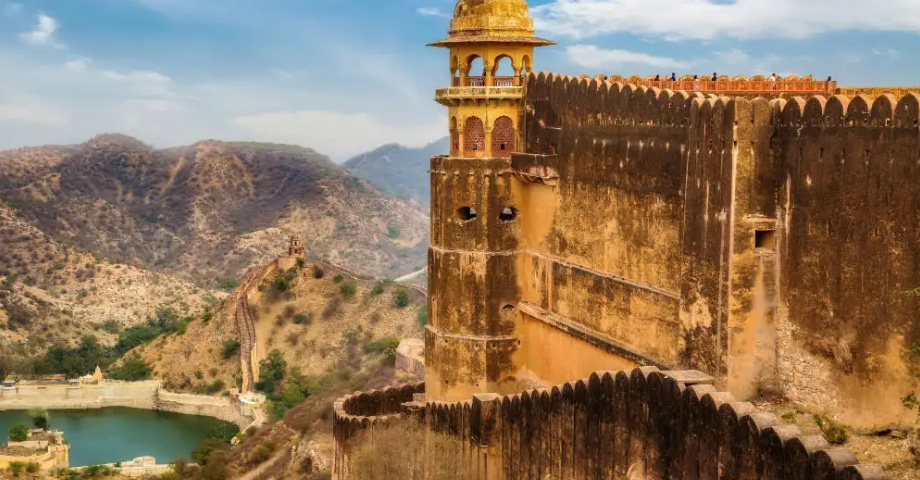- Have Any Question ?
- +91-9929358785
- 01414054824
- Info@thepinkcityholidays.com
Jaigarh Fort, Jaipur, India: Entry Fee, Timings, History, Built by, Images & Location

Complete Travel Guide for Nahargarh Fort Jaipur – Price, Ticket, Location, Images
June 1, 2025
Jal Mahal Jaipur, India (Entry Fee, Timings, History, Built by, Images & Location)
June 1, 2025Jaigarh Fort, Jaipur, India: Entry Fee, Timings, History, Built by, Images & Location
Jaigarh Fort proudly stands atop the “Cheel ka Teela or the Hill of Eagles,” in the Aravalli range. It’s imposing structure is a testament to the ingenuity of the architectural skills and the military strength of the Rajput rulers. The “Fort of Victory” was primarily built as a military fort, safeguarding the royal treasures and the most important approaches to the Amer Kingdom, and it commands a stunning view of the imposing Amber Fort and the serene Maota Lake.
No Jaipur trip can be complete without visiting Jaigarh Fort, which presents a unique contrast of history, incredible engineering and stunning views of the countryside. It’s rich history, highlights and all you need to consider for a memorable tour of Jaipur.
Location: The fort is strategically located around 15 kms northeast of Jaipur city center, near the town of Amer. Above Amer Fort, Devisinghpura, Amer, Jaipur, Rajasthan 302028, India.
Entry Timing:
Opening Hours: 9:00 AM
Closing Hours: 6:30 PM
Entry Fees:
Indian Tourists: Adults – INR 150 per person; Child (5 to 12 years) – INR 75 per person; Children below 5 years free; Student – INR 50 per person
Foreign Tourists: Adults – INR 200 per person; Child (5 to 12 years) – INR 100 per person; Children below 5 years free; Student – INR 100 per person.
Camera Charges: Still Camera – INR 50; Video Camera – INR 200
Best Time to Visit Jaigarh Fort:
The suitable time of the year is like most of Jaipur’s historical sites, is during the winter months (October to March). The weather is cool and pleasant, making it comfortable for discovering the extensive fort complex.
Early mornings allow you to avoid the peak crowds and experience the fort in a more serene atmosphere. It provides excellent opportunities for photography in softer light.
Late afternoons let you experience the sunset views, offering serenity.
Combine with Amber Fort due to their proximity and historical connection. Begin your day early to explore Amer Fort and then proceed to Jaigarh Fort.
Who Built Jaigarh Fort?
The Jaigarh fort was constructed during the reign of Maharaja Sawai Jai Singh II in 1726. He was the founder of Jaipur city and a visionary ruler known for his contribution to astronomy, mathematics and urban planning.
Historical Significance:
Jaigarh Fort’s ultimate purpose was military, as it offered an impassable defence against invasions and served as a fortified structure to defend the Amer Fort and its royal complex. Jaigarh Fort was mainly a military fortress, containing armouries, cannon foundries and strategic viewpoints, unlike other Rajasthani forts that often doubled as royal residences.
Jaigarh fort emerged as a foremost cannon foundry in the Mughal era, specifically in the 17th century. Owing to the rich deposits of iron ore in the region, its workshops yielded the finest artillery. All thanks to its strategic location, the fort never came under direct attack or was conquered in battle, and that’s why it earned the title of “Victory Fort.”
One most interesting events is the Mughal dynasty’s succession crisis during which time Aurangzeb’s elder brother Dara Shikoh held the cannon station at Jaigarh. But Aurangzeb’s ultimate defeat and beheading resulted in the fort’s control being altered. The fort’s military strength was subsequently transformed under Sawai Jai Singh II.
Major Attractions of Jaigarh Fort:
Jaivana Cannon is the world’s largest wheeled cannon, the Jaivana was built in 1720 during the reign of Sawai Jai Singh II.
The museum offers a rich collection of relics like stamps, old photographs of members of the royal family, and a display about the past of the fort.
An armoury of different types of guns and swords of the Rajput warriors is displayed in the fort.
Charbagh Garden is a Mughal garden featuring a well-manicured square lawn with four symmetrical sections and flower beds.
Conclusion –
Jaigarh Fort in Jaipur is a captivating tourist spot offering a profound understanding of Rajasthan’s military history and architectural grandeur. Its enormous structure is coupled with the awe-inspiring Javiana cannon and the panoramic views.





